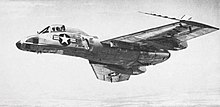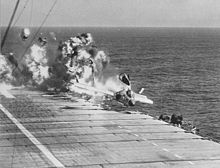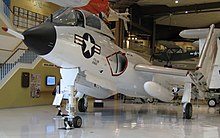
The McDonnell FH Phantom is a twinjet, straight-wing, carrier-based fighter aircraft designed and first flown during late World War II for the United States Navy. As a first-generation jet fighter, the Phantom was the first purely jet-powered aircraft to land on an American aircraft carrier and the first jet deployed by the United States Marine Corps. Although only 62 FH-1s were built it helped prove the viability of carrier-based jet fighters. As McDonnell's first successful fighter, it led to the development of the follow-on F2H Banshee, which was one of the two most important naval jet fighters of the Korean War; combined, the two established McDonnell as an important supplier of navy aircraft.

The McDonnell XF-88 Voodoo was a long-range, twinjet fighter aircraft with swept wings designed for the United States Air Force. Although it never entered production, its design was adapted for the subsequent supersonic F-101 Voodoo.

The McDonnell F2H Banshee is a single-seat carrier-based jet fighter aircraft designed and produced by the American aircraft manufacturer McDonnell Aircraft. It was an early jet fighter operated by United States Navy and United States Marine Corps, as well as being the only jet-powered fighter to ever be deployed by the Royal Canadian Navy. The aircraft's name is derived from the banshee of Irish mythology.
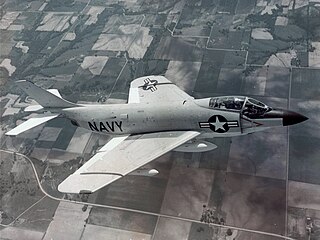
The McDonnell F3H Demon is a subsonic swept-wing carrier-based jet fighter aircraft designed and produced by the American manufacturer McDonnell Aircraft Corporation. It was the first swept wing jet fighter and the only single-engined carrier-based fighter the company produced.
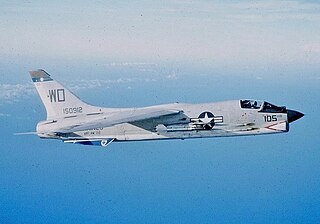
The Vought F-8 Crusader is a single-engine, supersonic, carrier-based air superiority jet aircraft designed and produced by the American aircraft manufacturer Vought. It was the last American fighter that had guns as the primary weapon, earning it the title "The Last of the Gunfighters".

The LTV A-7 Corsair II is an American carrier-capable subsonic light attack aircraft designed and manufactured by Ling-Temco-Vought (LTV).

The Grumman F11F/F-11 Tiger is a supersonic, single-seat carrier-based fighter aircraft designed and produced by the American aircraft manufacturer Grumman. For a time, it held the world altitude record of 76,939 feet (23,451 m), as well as being the first supersonic fighter to be produced by Grumman.
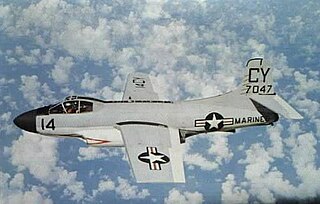
The Douglas F3D Skyknight is an American twin-engined, mid-wing jet fighter aircraft designed and manufactured by the Douglas Aircraft Company.

The Douglas F4D Skyray is an American carrier-based fighter/interceptor designed and produced by the Douglas Aircraft Company. It was the last fighter produced by the Douglas Aircraft Company prior to its merger with McDonnell Aircraft to become McDonnell Douglas.

The Convair F2Y Sea Dart was an American seaplane fighter aircraft that rode on twin hydro-skis during takeoff and landing. It flew only as a prototype, and never entered mass production. It is the only seaplane to have exceeded the speed of sound.

The Ryan FR Fireball was an American mixed-power fighter aircraft designed by Ryan Aeronautical for the United States Navy during World War II. It was the Navy's first aircraft with a jet engine. Only 66 aircraft were built before Japan surrendered in August 1945. The FR-1 Fireball equipped a single squadron before the war's end, but did not see combat. The aircraft ultimately proved to lack the structural strength required for operations aboard aircraft carriers and was withdrawn in mid-1947.

The Vought F6U Pirate was the Vought company's first jet fighter, designed for the United States Navy during the mid-1940s. Although pioneering the use of turbojet power as the first naval fighter with an afterburner and composite material construction, the aircraft proved to be underpowered and was judged unsuitable for combat. None were ever issued to operational squadrons and they were relegated to development, training, and test roles before they were withdrawn from service in 1950.

The Westinghouse J40 was an early high-performance afterburning turbojet engine designed by Westinghouse Aviation Gas Turbine Division starting in 1946 to a US Navy Bureau of Aeronautics (BuAer) request. BuAer intended to use the design in several fighter aircraft and a bomber. However, while an early low-power design was successful, attempts to scale it up to its full design power failed, and the design was finally abandoned, deemed a "fiasco" and a "flop".

The Westinghouse J34, company designation Westinghouse 24C, was a turbojet engine developed by Westinghouse Aviation Gas Turbine Division in the late 1940s. Essentially an enlarged version of the earlier Westinghouse J30, the J34 produced 3,000 pounds of thrust, twice as much as the J30. Later models produced as much as 4,900 lb with the addition of an afterburner. It first flew in 1947. The J46 engine was developed as a larger, more powerful version of Westinghouse's J34 engine, about 50% larger.

The Westinghouse J46 is an afterburning turbojet engine developed by the Westinghouse Aviation Gas Turbine Division for the United States Navy in the 1950s. It was primarily employed in powering the Convair F2Y Sea Dart and Vought F7U Cutlass. The engine also powered the land speed-record car known as the Wingfoot Express, designed by Walt Arfons and Tom Green It was intended to power the F3D-3, an improved, swept-wing variant of the Douglas F3D Skyknight, although this airframe was never built.
The Westinghouse Aviation Gas Turbine Division (AGT) was established by Westinghouse Electric Corporation in 1945 to continue the development and production of its turbo-jet gas turbine engines for aircraft propulsion under contract to the US Navy Bureau of Aeronautics. The AGT Division was headquartered in Kansas City, Missouri, where it remained in operation until 1960 when Westinghouse decided to focus on industrial and electric utility gas turbines.

Rear Admiral Edward Lewis Feightner was a United States Navy officer who fought in a number of significant battles in the World War II Pacific Theater of Operations. During two combat tours, he shot down nine enemy aircraft to become a flying ace.

VA-34, nicknamed the Blue Blasters, was an Attack Squadron of the U.S. Navy. The squadron was established as Fighter Squadron VF-20 on 15 October 1943, redesignated as VF-9A on 15 November 1946, as VF-91 on 12 August 1948, and as VF-34 on 15 February 1950. It was finally redesignated VA-34 on 1 July 1955. The squadron was disestablished on 1 June 1969. It was the second squadron to bear the VA-34 designation, the first one having been renamed VA-35 in 1950.

Attack Squadron TWELVE, also known as the "Flying Ubangis" or "Clinchers", was an attack squadron of the United States Navy active during the Cold War. From their home port at Naval Air Station Cecil Field in Florida, the squadron made more than thirty major overseas deployments aboard aircraft carriers, primarily flying A-4 Skyhawk and later the A-7E Corsair II, including two combat tours in the Vietnam War.
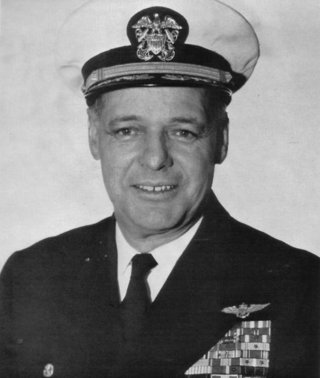
George Chamberlain Duncan was a highly decorated United States Navy officer, World War Two veteran and flying ace. Born in Tacoma, Washington, he was credited with destroying 13+1⁄2 enemy aircraft and was awarded the Navy Cross during World War II.



